Johnson County’s Little Store is no more, but KCQ finds vivid memories 60 years later
“What’s your KC Q” is a joint project of the Kansas City Public Library and The Kansas City Star. Readers submit questions, the public votes on which questions to answer, and our team of librarians and reporters dig deep to uncover the answers.
Have a question you want to ask? Submit it now »
by Dan Kelley | dkelly@kcstar.com
Isn’t it odd how you can forget where you left your cellphone five minutes after using it but can recall in vivid detail when and where you heard a certain song for the first time decades ago?
Or, in Ken Kelly’s case, when and where he drank his first Tab.
For those unfamiliar with Tab, the product debuted in 1963 and launched the diet soft drink industry, but Coca-Cola announced in mid-October that the company is discontinuing it because of declining sales.
But young Ken Kelly (no relation to this reporter) thought Tab tasted almost as good as his beloved Coke. “I was impressed at the time,” he says now.
But what has stuck with him all these years isn’t the taste so much as the place.
“I enjoyed my first Tab in the Little Store,” he said.
“I remember spending many hours there after school. I can still see exactly where everything was, the counter, the pinball machines, everything. Mr. Hamilton, he stood behind that big counter, and the kids stood in line waiting to get their penny candy. We were in heaven.”
So maybe it’s appropriate that he is now the Rev. Ken Kelly, pastor of St. Pius X Catholic Church in Mission. Sixty or so years ago, he was among a band of grade-school kids for whom the Little Store in Roeland Park was huge part of growing up. The big draws were penny candy, Coca-Cola in 6.5-ounce bottles for a nickel and pinball machines.
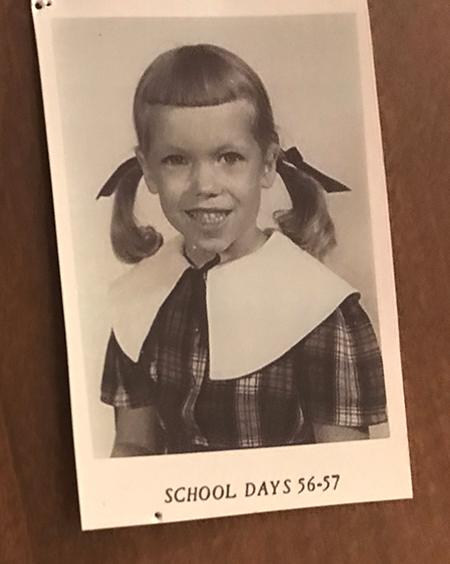
Another part of the group was Ken’s sister Rita (now Rita Zeller), who brought the Little Store to our attention with her query to “What’s Your KCQ?,” an ongoing series in which The Star and the Kansas City Public Library partner to answer readers’ queries about our region:
“The Little Store in Roeland Park was a popular spot for kids growing up in the 1950s and ’60s, at 51st Street and Buena Vista. Prior history?”
For starters, the Little Store wasn’t the place’s actual name. It was the Buena Vista Market, though nobody called it that, operated by Everett Hamilton, who would go on to have a famous Kansas City area grandson (more on him in a bit).
The 2,165-square-foot building — officially, 4301 W. 51st St. — maintained its Little Store moniker for a relatively short period in the late 1950s and early 1960s during a nearly 100-year history.
It has been home to the Buena Vista Art Studio for about the past 16 years, according to owner Ellen Sweeney. In the three previous decades it housed Major League Memories, the Buena Vista Beauty Salon, T&M Coins and a record store. But for most of its history, the building operated as a market of one kind or another, with the proprietors often living upstairs.
It is the oldest commercial building in Roeland Park, having been built in 1925, according to Johnson County assessor records. The Bown family operated it as the Southridge Market from its origin through about 1940.
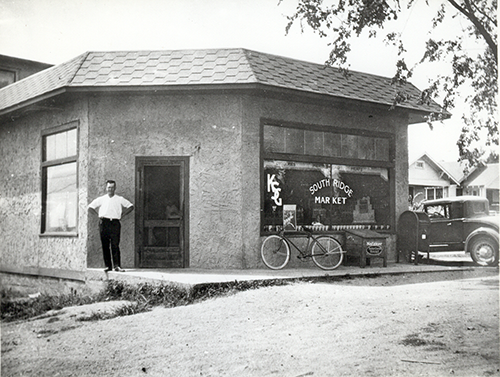
through about 1940. This photo was from the early 1930s. | Courtesy of Johnson County Museum
Along the Strang Line
The building owes its existence to the Strang Line, the interurban railway that served the area – known in the early days as Southridge — from 1906 to 1940.
The Strang Line route went from Kansas City to Olathe, more or less following what had been the Santa Fe Trail. (In fact, the building’s original address was 4601 Santa Fe Trail Drive.) The line entered an “S” curve through Southridge that the current 51st Street still follows. The Southridge station was a short walk west of the Bowns’ market.
Carl Johnson lived within a block of the store in the 1920s and still lived there in 1996, when John R. Scott wrote “Roe’ling Through the Years in Roeland Park, Kansas: A History,” which the city’s website contains in its entirety. Johnson provided memories of the Southridge area for the book, including a few colorful ones.
He said the Bowns’ store “was originally constructed with wood from old wooden boxes” and was not far from a gambling den. “Someone, who had lost money there, bombed the house, and a part of a piano was blown clear to Roesland School,” Johnson said in the book. Also nearby was a nudist colony, where “they had barbecues and other entertainment, walking around in the buff.”
There was no nudism at the Little Store, as far as we know. But there was some mischief.
Kathleen Whitworth, who frequented the Little Store after classes let out at nearby Roesland Elementary, recalls that she and her friends would convince Mr. Hamilton that an uncle was in town and that they were tasked with fetching cigarettes and cigars for him.
“We could be pretty convincing,” Whitworth said.
“We’d go to the neighbor’s garden and smoke. We’d talk hillbilly and swear. And we’d get those big old stogies. Here we were in the fourth grade doing these things.”
Don’t worry. The fourth-graders didn’t inhale.
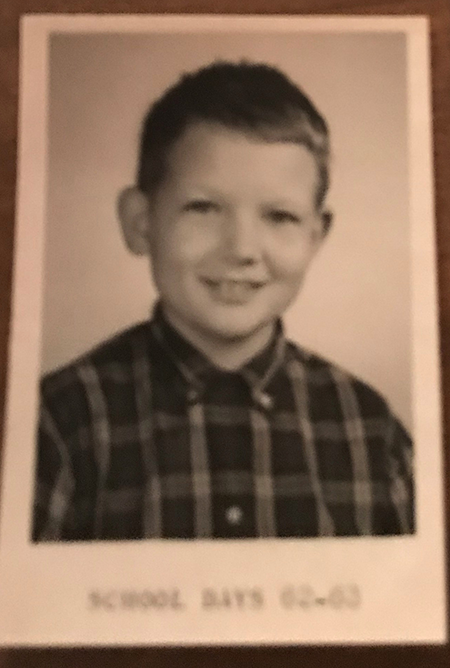
Ken Kelly has his own memory of mischief.
“I remember my dad gave me $2 to buy Christmas presents at the Little Store,” he said. “I was probably in the third grade. I went there and spent it all on pinball, candy and Coke. I can remember getting a really bad spanking. I don’t have many spanking memories, but this was one.”
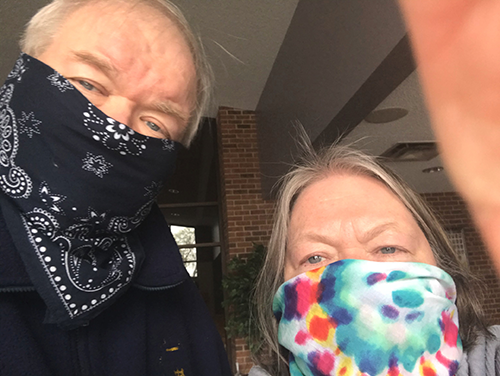
Ken and Rita Kelly were among a slew of kids from St. Agnes Catholic School who turned the Little Store into their headquarters.
“It was primarily an Irish-Catholic neighborhood,” Whitworth said. “We had some ornery Irish-Catholic kids in the neighborhood.”
Whitworth, who lives in the house where she grew up a few blocks from the Little Store, had a different set of Little Store friends who attended Roesland. The St. Agnes and Roesland contingents operated independently, but evidently peacefully.
On the St. Agnes side were Bob and Melanie Stone, now Melanie Nolker. As artists, both are born-again regulars at 4301 W. 51st. In fact, Stone’s “Penny Candy” sculpture adorns the Buena Vista Art Studio’s front porch.
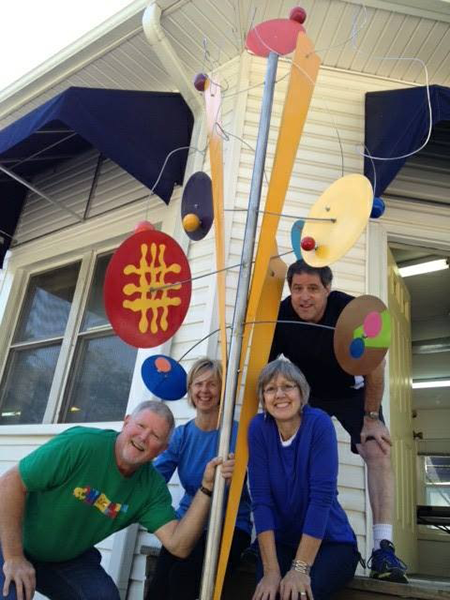
from left, wife Patti King Stone, studio owner Ellen Sweeney and husband Mike Sweeney.
“To me and my brother, it was a big deal to meet there,” Nolker said.
“What I remember most is we went home from school, got on our bikes and met at the Little Store. We would go in and get penny candy and Cokes.”
Nolker returned to the area about 16 years ago after living elsewhere, and her heart jumped when she drove past what had been the Little Store.
“It became my place again,” she said. “In fact, I paint in the exact same spot where I used to buy penny candy.
“It’s kind of an ode to those times. It looks almost exactly as it did then.”
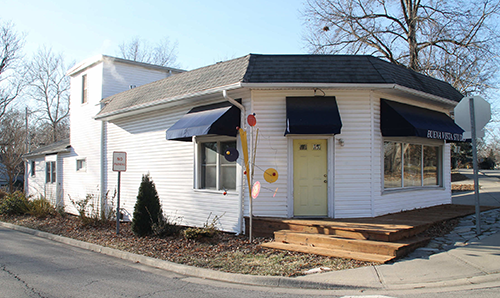
What had been an upstairs living area is now used for storage, according to owner Ellen Sweeney.
Remembering Mr. Hamilton
At the Little Store’s core was the proprietor, Mr. Hamilton.
Everett Hamilton took over the building no earlier than 1955, when a classified ad in The Star showed it was operating as a meat market and was for sale. His father’s obituary indicated the family was living at the store’s address in 1958. Everett’s own 1988 obituary, which described him as a sporting goods buyer from 1920 through 1945 and then as a builder and home remodeler for 18 years, said he retired from the Little Store in 1963.
So his run at the Little Store was no more than eight years, but he left a lasting impression.
“He was very receptive to children,” Whitworth said. “He put up with us.”
“My memory of him was that he was very patient,” Kelly said. “He must have been thinking, ‘This is my life?’”
Mark Hamilton, Everett Hamilton’s son who now lives in Gig Harbor, Washington, said the building was vacant when his parents took it over, which he estimated was in 1957. He said the Little Store was more or less an afterthought.
His mother, Sarah, was a hairdresser, and the plan was to use the building for her business. But she didn’t need all the space, so Everett decided to operate a small market in the front with Sarah’s salon in the back. The family lived in the building briefly during the early days.
Mark Hamilton, whose son Adam Hamilton is the founding pastor of the 20,000-plus-member United Methodist Church of the Resurrection based in Leawood, sometimes filled in for his father behind the counter when he was barely older than many of the customers.
One of his most vivid memories was from a March night in 1962 that nearly spelled the end of the landmark building.
“I remember, the phone rang late at night and we were told we had to get over to the store,” he said. “When we got there, we saw red lights flashing everywhere. The place was on fire. Somebody had thrown a Molotov cocktail kind of thing through the window.”
A lot of merchandise had to be replaced, but the Little Store soldiered on. It continues to do so today, even if only in the minds of grateful senior citizens with happy memories.
Submit a Question
Do you want to ask a question for a future voting round? Kansas City Star reporters and Kansas City Public Library researchers will investigate the question and explain how we got the answer. Enter it below to get started.


